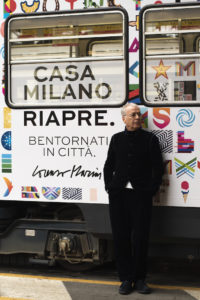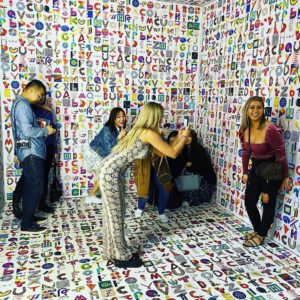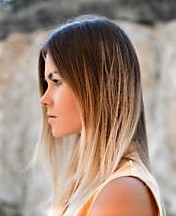In Piazza San Marco in Venice, the spaces of the Bevilacqua La Masa Foundation host from June 24 to August 30 “Dal Silenzio alla Parola (From silence to speech)”, an anthological exhibition dedicated to Lorenzo Mariani and curated by Sabino Maria Frassà. After the Milan, Dubai, Paris and Los Angeles Art Fair, Venice hosts an exhibition that celebrates the artistic path of the founder of “TypeArt”, an artistic trend focused on the liberation of printed letters. The exhibition traces the artist’s career as if it were a path of catharsis aimed at finding the “Word” that fills the “silence” of everyday life. His painting, as emerged in the”Out of Words” exhibition in Gaggenau Hub in Milan starts from the desire to desemantise the consumer object and its advertising message, stripping down a concept to a mere grid where the act of commodification is canceled by beauty and composition of the elements. The urgency to communicate, also the result of the health emergency that we experienced, led the reflection to rethink also his art to seek and find that “word” that only a few months ago in the Milanese exhibition the artist seems to have lost.
We delved into these issues by asking him some questions.
Venice is the city of your youth education: in 1980 you left the Academy of Fine Arts where you attended Emilio Vedova’s courses to graduate in architecture and enter the world of advertising. How has your Master’s gestural and expressive approach influenced this subsequent, much more rational and controlled path?
Pure art was a mental luxury that I could not afford. I needed to balance fantasy with logic: architecture is a science that incorporates many others in itself. I practically left the downhill run for the giant slalom. I love and look for limits, I cultivate discipline, since my nature would be the opposite. The common thing behind every creative project is the method. Feel free to ask the chefs. Designing a hospital or church has the same methodology as making a risotto. Creating an advertising campaign for a car or a suppository requires the same design paths. The analysis of the situation. The synthesis. The target. The strategy. The concept. And the execution. Simple. Emilio Vedova had just arrived at teaching at the Academy. He had an inexhaustible energy, he loved and he was loved. For many students his personality was overwhelming; difficult to resist and maintain your own style. I have had many teachers in my life. In advertising, for example, it was Armando Testa. I love them all, but I always remain a student. I will be myself only learning until my last day here, on planet Earth.
What are the letters for you, which constitute the founding code of your painting and the current “TypeArt” that you founded?
The letters are pieces of architecture, they are fragments of words, crumbs of poetry, scraps of grammar, signs combined in a random order. They are slaves to logic and function, but now we have raised them to works of art to sculptures like the ones I proposed in the “Out of Words” exhibition at Gaggenau Design Elements Hub in Milan. They are the interpretative possibility, they are the graft between sign and design, between meaning and signifier. They are the fusion of hieroglyph and emoticon. They are democratically promoted to the rank of a landscape, portrait, still life. These are the new territories of art, started by the cubists with fragments of newspapers on their canvases, ungrammatical and turned into sound by the futurists, which have become precisely and sketched in the works of Cy Twombly and finally cleared by Basquiat, who canceled them to underline them. The letters are tiles on an uncoordinated wall. They are mosaic tiles that follow the logic of the chance.
Your professional and artistic career is centered on the union between form and content, understood as the extremes of a constantly evolving pendulum. Do you think that the form implies its own specific content or that the two elements can also exist without one another?
The style of a person intrigues, but it is the character that fascinates. The relationship we establish is with the idea, with the concept. The only form is talcum powder. Form and content are the subject of a debate that has never been closed and never resolved, from the philosophy of the last century to post-modernism. There is much discussion as to whether art is form or content, and that this needs that. I’m interested in the concept. The essence. The theme. Without this, any object is devoid of soul. The concept is necessarily expressed through a form. But the form without concept has the fascination of emptiness. The ocean can live without the waves, but the waves don’t exist without the ocean.
What elements determine the functioning of the relationship between form and content in language and communication?
The idea of the pendulum between form and content is an interpretation by the curator Sabino Maria Frassà who has learned to know me, tell me and explain me over the years. Sometimes it makes me laugh, it often intrigues and fascinates me: I learn and we learn from each other, also an artist and curator. This pendulum depends a lot on time and historical context: we think about what we are experiencing. I too went from the Out of Words of the exhibition in Milan to the desire for life and joy with public art on trams. So if there is an element, it is the method of analyzing reality that starts from listening.
Public success came to you very early as an art director in advertising. What impulse drove you to approach painting again?
I consider myself a very lucky person. Really. As a creative I have never suffered, not even in competition difficulties. “You can’t get along with others if you don’t get along with yourself,” said Sri Yogananda. The act of creation is a natural, spontaneous fact. There is no effort in the bud that grows or in the rose that smells. In the 80s and 90s, being creative was the trendiest and most profitable thing in the world. In these 40 years I have won over 400 awards. Beautiful world. But now that river has dried up, and the wind has changed direction. Technology has the pride of using creativity as an algorithm. And it can also do it. Except that the end result is global approval. Big data can also reproduce a Rembrandt painting based on the memories of his brush strokes. But it will never be Rembrandt. Genius presupposes the leap in conventional logics. Courage feels uncomfortable in the middle of the bytes. I approached painting again, you ask me. In fact, I never left her. Only that I painted at night, in silence, with white. Without showing anything to anyone. Because I didn’t feel the need for it.
What did you learn from oriental culture and its refined cult of calligraphy?
The east is the only hope for the west. Now that we have all the objects we need and especially we are full of those that we don’t need, we are discovering that what is missing is inside. During the lockdown, yoga mats were snapped up. Silence forces you to introspect. What did I learn? To eat better, not to kill, to remain calm, to cultivate happiness at all times, to find beauty in everything. Even in your questions. By studying Chinese calligraphy in Beijing I appreciated the beauty of using the brush to paint letters, which writing would be a wrong verb. But the thing that drives me crazy is the synthesis. Ideograms are the marks of past centuries.
After working for twenty years in total silence and confidentiality, defending your works from the clamor of advertising, you have decided to share your artistic research by making it public. What made you realize that the right time had come and what was holding you back before?
There is a moment when you feel that the river has reached the sea. There you stop being alone and start sharing.
The AlphaCube installation is an immersive and interactive work, a three-dimensional environment in which even man can try to “be a letter”. Do you think you will further develop this participatory approach to art in other works?
Alphacube is the painting that embraces you, becomes floor, wall and ceiling. I had no idea how with a simple reasoning it would have been so successful, even beyond the meaning I had given him, even beyond the reflections shared and elaborated with Frassà. It was a highly conceptual work, the inverse of the white cube and a satire on the world of art: where is art? Everything is dadaistically art. Yet in Los Angeles there was a line to take selfies inside the cube. The eyes became children again, finding the letters means finding your name, your story. Looking for an interpretation of my Type becomes a dialogue, but also a game, a reference, a hide and seek. In short, a form of participation. I will certainly develop other immersive elements. I am thinking of a large white cage from which many colored letters fly like leaves in the wind. A nineteenth-century aviary.
Info:
Lorenzo Mariani. Dal silenzio alla parola (From silence to speech)
curated by Sabino Maria Frassà
24 June – 30 August 2020
Fondazione Bevilacqua La Masa
Marco, 71/C, Venezia
 Portrait of Lorenzo Mariani
Portrait of Lorenzo Mariani
 Lorenzo Mariani, ADVISUAL 30, Los Angeles, 2014, acrylic, chalk, graphite paste on canvas
Lorenzo Mariani, ADVISUAL 30, Los Angeles, 2014, acrylic, chalk, graphite paste on canvas
 Lorenzo Mariani, Type Visual F, mixed media, 2016
Lorenzo Mariani, Type Visual F, mixed media, 2016
 Lorenzo Mariani, ALPHATYPE, Milan, 2019, mixed media on canvas
Lorenzo Mariani, ALPHATYPE, Milan, 2019, mixed media on canvas
 Lorenzo Mariani, Alphacube, 2019
Lorenzo Mariani, Alphacube, 2019

Graduated in contemporary art, has been working in collaboration with various contemporary art galleries, private foundations, art centers in Italy and abroad.






NO COMMENT